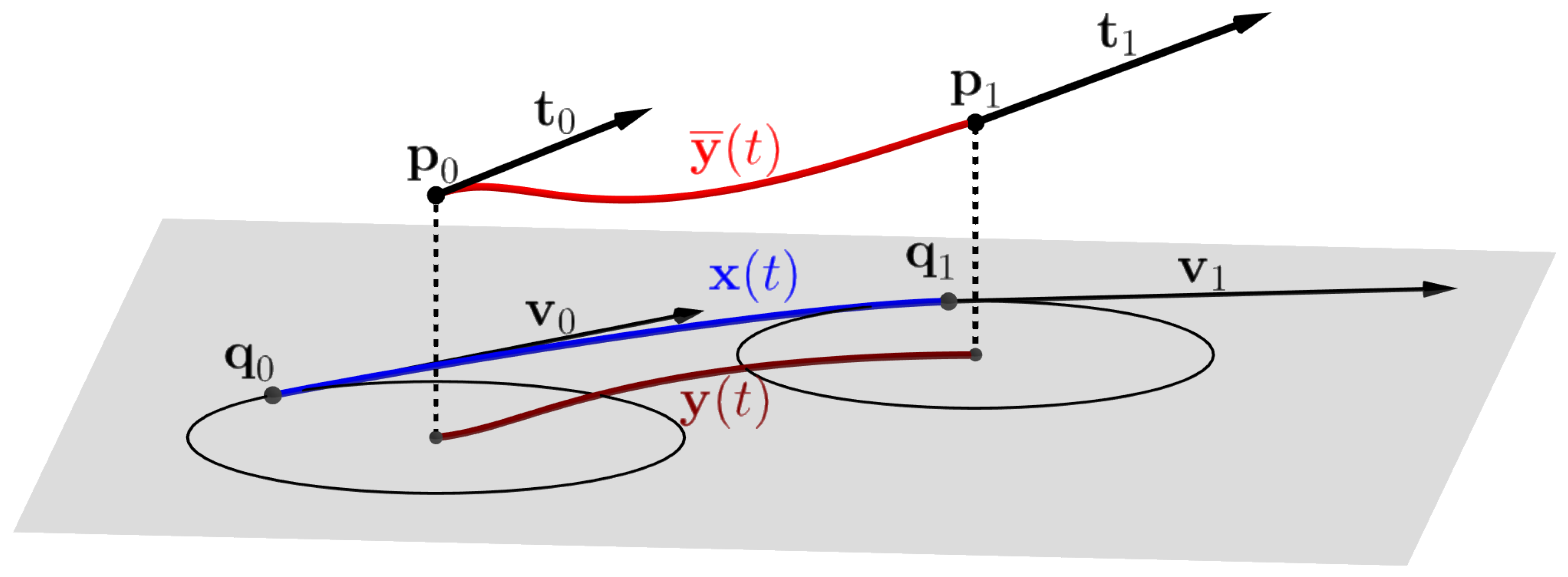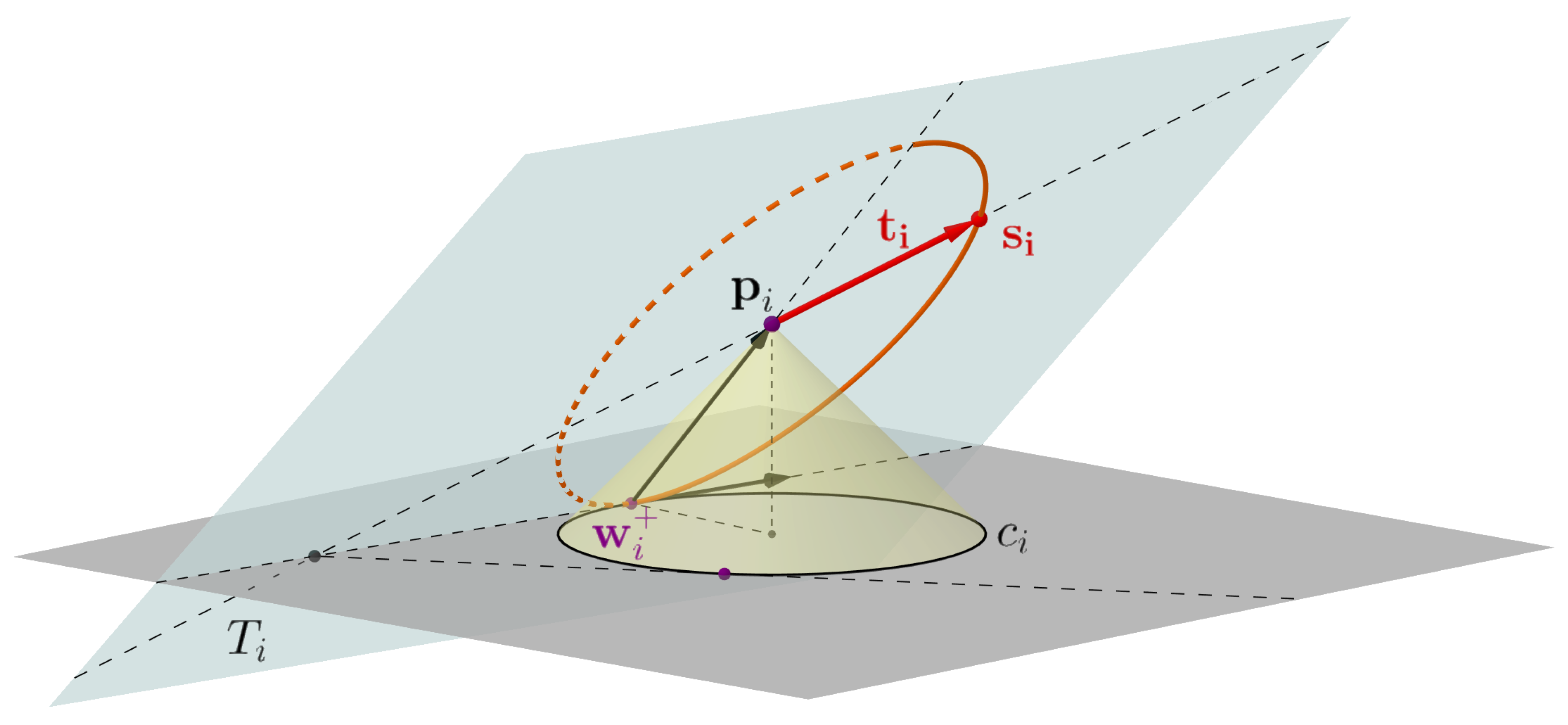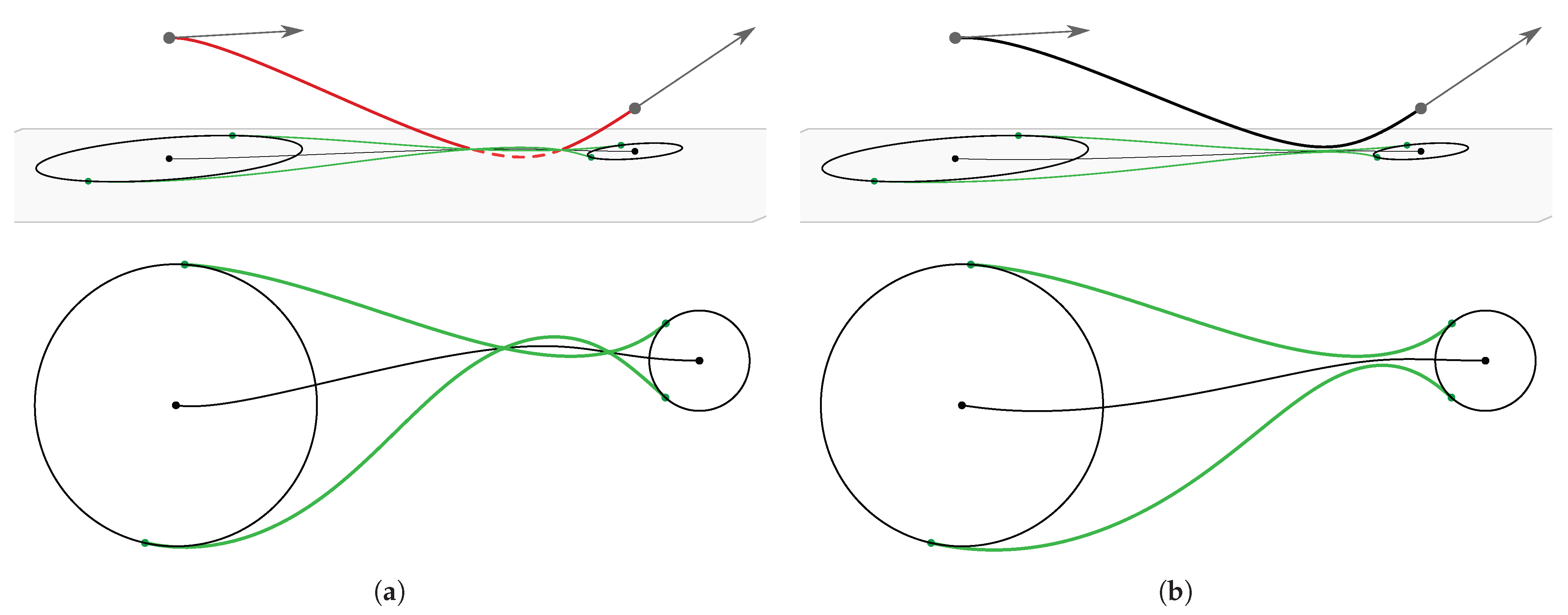Possibilities and Advantages of Rational Envelope and Minkowski Pythagorean Hodograph Curves for Circle Skinning
Abstract
1. Introduction
2. Motivation and Previous Work
2.1. Rational Envelope (RE) Curves
2.2. Applying RE/MPH Curves for Skinning
3. Using RE/MPH Curves for Skinning with More Flexibility
3.1. Determining the Tangent Vectors
3.2. Constructing the Envelope Curves
| Algorithm 1 A flexible approach for using RE/MPH curves for skinning purposes |
| Require: An admissible sequence of circles |
| Ensure: The skinning curves as envelope curves with continuity |
| 1: |
| 2: |
| 3: for to do |
| 4: |
| 5: for to n do |
| 6: |
| 7: ▹ see (11) |
| 8: |
| 9: for to do |
| 10: |
| 11: ▹ see (12) |
| 12: |
| 13: ▹ see (13) and (14) |
| 14: ▹ see (15) |
| 15: ▹ see (16) |
| 16: |
| 17: return |
4. Intersections of the Envelope Curves
4.1. Intersection Detection
- , or
- , that is, the tangent vector of at the parameter value is light-like.
- If , then .
- If , then the equation can be written asSince , rearranging the equation we getthus, .
- If the third coordinate is zero for a point on the MAT, then it means that the radius of the corresponding cycle is zero. A cycle of zero radius is called null-cycle, and it is interpreted as a point. Moreover, the tangent lines drawn to this null-cycle touch it at the same point, thus this point becomes the point of the envelopes, i.e., .
- If the tangent vector of the MAT at parameter value is light-like, then the tangent line at is a generator line of the representing cone of . In this case, the piercing point of the tangent line and the plane is a point on the cycle. As it is not possible to draw tangent lines from this point to the cycle, then the point of the envelope cannot be anything else than the point itself, so .
- is irregular and is a singular point;
- is regular, but holds; or
- , i.e., the tangent vector of the RE curve at the parameter value is light-like.
4.2. Eliminating the Intersections
5. Conclusions
Author Contributions
Funding
Conflicts of Interest
References
- Moon, H.P. Minkowski Pythagorean hodographs. Comput. Aided Geom. Des. 1999, 16, 739–753. [Google Scholar] [CrossRef]
- Choi, H.I.; Choi, S.W.; Moon, H.P. Mathematical theory of medial axis transform. Pac. J. Math. 1997, 181, 57–88. [Google Scholar] [CrossRef]
- Choi, H.I.; Han, C.Y.; Moon, H.P.; Roh, K.H.; Wee, N.S. Medial axis transform and offset curves by Minkowski Pythagorean hodograph curves. Comput. Aided Des. 1999, 31, 59–72. [Google Scholar] [CrossRef]
- Kosinka, J.; Jüttler, B. G1 Hermite interpolation by Minkowski Pythagorean hodograph cubics. Comput. Aided Geom. Des. 2006, 23, 401–418. [Google Scholar] [CrossRef]
- Kosinka, J.; Šír, Z. C2 Hermite interpolation by Minkowski Pythagorean hodograph curves and medial axis transform approximation. Comput. Aided Geom. Des. 2010, 27, 631–643. [Google Scholar] [CrossRef]
- Kosinka, J.; Jüttler, B. C1 Hermite interpolation by Pythagorean hodograph quintics in Minkowski space. Adv. Comput. Math. 2009, 30, 123–140. [Google Scholar] [CrossRef]
- Bizzarri, M.; Lávička, M.; Vršek, J. Linear computational approach to interpolations with polynomial Minkowski Pythagorean hodograph curves. J. Comput. Appl. Math. 2019, 361, 283–294. [Google Scholar] [CrossRef]
- Kim, G.I.; Ahn, M.H. C1 Hermite interpolation using MPH quartic. Comput. Aided Geom. Des. 2003, 20, 469–492. [Google Scholar] [CrossRef]
- Kosinka, J.; Lávička, M. A unified Pythagorean hodograph approach to the medial axis transform and offset approximation. J. Comput. Appl. Math. 2011, 235, 3413–3424. [Google Scholar] [CrossRef]
- Bizzarri, M.; Lávička, M.; Kosinka, J. Medial axis transforms yielding rational envelopes. Comput. Aided Geom. Des. 2016, 46, 92–102. [Google Scholar] [CrossRef]
- Bizzarri, M.; Lávička, M.; Kosinka, J. Skinning and blending with rational envelope surfaces. Comput. Aided Des. 2017, 87, 41–51. [Google Scholar] [CrossRef]
- Peternell, M.; Odehnal, B.; Sampoli, M.L. On quadratic two-parameter families of spheres and their envelopes. Comput. Aided Geom. Des. 2008, 25, 342–355. [Google Scholar] [CrossRef]
- Pottmann, H.; Wallner, J. Computational Line Geometry; Springer: Berlin/Heidelberg, Germany, 2010. [Google Scholar]
- Kunkli, R.; Hoffmann, M. Skinning of circles and spheres. Comput. Aided Geom. Des. 2010, 27, 611–621. [Google Scholar] [CrossRef]
- Bastl, B.; Kosinka, J.; Lávička, M. Simple and branched skins of systems of circles and convex shapes. Graph. Model. 2015, 78, 1–9. [Google Scholar] [CrossRef]
- Bana, K.; Kruppa, K.; Kunkli, R.; Hoffmann, M. KSpheres—An efficient algorithm for joining skinning surfaces. Comput. Aided Geom. Des. 2014, 31, 499–509. [Google Scholar] [CrossRef]
- Kruppa, K.; Kunkli, R.; Hoffmann, M. An improved skinning algorithm for circles and spheres providing smooth transitions. Graph. Model. 2019, 101, 27–37. [Google Scholar] [CrossRef]
- Connolly, M.L. Analytical molecular surface calculation. J. Appl. Crystallogr. 1983, 16, 548–558. [Google Scholar] [CrossRef]
- Edelsbrunner, H. Deformable smooth surface design. Discret. Comput. Geom. 1999, 21, 87–115. [Google Scholar] [CrossRef]
- Rossignac, J.; Whited, B.; Slabaugh, G.; Fang, T.; Unal, G. Pearling: 3D interactive extraction of tubular structures from volumetric images. In Proceedings of the MICCAI Workshop on Interaction in Medical Image Analysis and Visualization, Brisbane, Australia, 29 October– 2 November 2007. [Google Scholar]
- Piskin, S.; Unal, G.; Arnaz, A.; Sarioglu, T.; Pekkan, K. Tetralogy of Fallot Surgical Repair: Shunt Configurations, Ductus Arteriosus and the Circle of Willis. Cardiovasc. Eng. Technol. 2017, 8, 107–119. [Google Scholar] [CrossRef] [PubMed]
- Kruppa, K. Applying Rational Envelope curves for skinning purposes. Front. Inf. Technol. Electron. Eng. 2021, 22, 202–209. [Google Scholar] [CrossRef]
- Farouki, R.T.; Sakkalis, T. Pythagorean hodographs. IBM J. Res. Dev. 1990, 34, 736–752. [Google Scholar] [CrossRef]
- Farouki, R.T.; Giannelli, C.; Sestini, A. New Developments in Theory, Algorithms, and Applications for Pythagorean-Hodograph Curves. In Advanced Methods for Geometric Modeling and Numerical Simulation; Giannelli, C., Speleers, H., Eds.; Springer International Publishing: Cham, Switzerland, 2019; pp. 127–177. [Google Scholar] [CrossRef]
- Bizzarri, M.; Lávička, M. Interpolation of Hermite data by clamped Minkowski Pythagorean hodograph B-spline curves. J. Comput. Appl. Math. 2021, 392. [Google Scholar] [CrossRef]
- Tornai, R. Measurement of visual smoothness of blending curves. Ann. Math. Inform. 2012, 40, 155–160. [Google Scholar]
- Sederberg, T.W.; Nishita, T. Curve intersection using Bézier clipping. Comput. Aided Des. 1990, 22, 538–549. [Google Scholar] [CrossRef]
- Lou, Q.; Liu, L. Curve intersection using hybrid clipping. Comput. Graph. 2012, 36, 309–320. [Google Scholar] [CrossRef]
- Bartoň, M.; Jüttler, B. Computing roots of polynomials by quadratic clipping. Comput. Aided Geom. Des. 2007, 24, 125–141. [Google Scholar] [CrossRef]
- Liu, L.; Zhang, L.; Lin, B.; Wang, G. Fast approach for computing roots of polynomials using cubic clipping. Comput. Aided Geom. Des. 2009, 26, 547–559. [Google Scholar] [CrossRef]
- Ko, K.H.; Kim, K. Improved subdivision scheme for the root computation of univariate polynomial equations. Appl. Math. Comput. 2013, 219, 7450–7464. [Google Scholar] [CrossRef]
- Chen, X.D.; Ma, W.; Ye, Y. A rational cubic clipping method for computing real roots of a polynomial. Comput. Aided Geom. Des. 2015, 38, 40–50. [Google Scholar] [CrossRef]
- Li, S.; Chen, G.; Wang, Y. An improved rational cubic clipping method for computing real roots of a polynomial. Appl. Math. Comput. 2019, 349, 207–213. [Google Scholar] [CrossRef]







Publisher’s Note: MDPI stays neutral with regard to jurisdictional claims in published maps and institutional affiliations. |
© 2021 by the authors. Licensee MDPI, Basel, Switzerland. This article is an open access article distributed under the terms and conditions of the Creative Commons Attribution (CC BY) license (https://creativecommons.org/licenses/by/4.0/).
Share and Cite
Kruppa, K.; Kunkli, R.; Hoffmann, M. Possibilities and Advantages of Rational Envelope and Minkowski Pythagorean Hodograph Curves for Circle Skinning. Mathematics 2021, 9, 843. https://doi.org/10.3390/math9080843
Kruppa K, Kunkli R, Hoffmann M. Possibilities and Advantages of Rational Envelope and Minkowski Pythagorean Hodograph Curves for Circle Skinning. Mathematics. 2021; 9(8):843. https://doi.org/10.3390/math9080843
Chicago/Turabian StyleKruppa, Kinga, Roland Kunkli, and Miklós Hoffmann. 2021. "Possibilities and Advantages of Rational Envelope and Minkowski Pythagorean Hodograph Curves for Circle Skinning" Mathematics 9, no. 8: 843. https://doi.org/10.3390/math9080843
APA StyleKruppa, K., Kunkli, R., & Hoffmann, M. (2021). Possibilities and Advantages of Rational Envelope and Minkowski Pythagorean Hodograph Curves for Circle Skinning. Mathematics, 9(8), 843. https://doi.org/10.3390/math9080843






